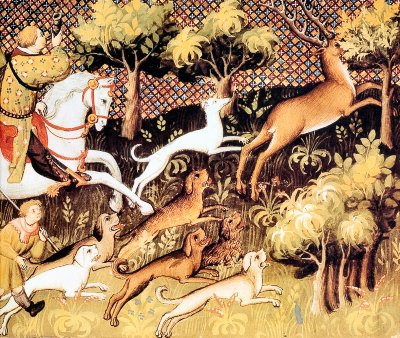
Gaston Febus: Livre de la chasse (1387)
Restricting access
to game, designating reserved areas, protecting valued beasts from
indiscriminate slaughter had already in the Middle Ages signaled
the extent to which human settlements had encroached on the wild.
Access was only limited in countries of dense settlement and little
unproductive land, such as England. It was not a problem in
underpopulated lands like Spain or eastern
Europe.
Beyond the
cultivated zone lay the primeval woodlands of northern Europe,
offering apparently inexhaustible supplies of many raw materials
including timber itself. Pigs were driven there to fatten up
in the summer. Villagers collected such food as berries and
honey there. They killed beasts and found the materials for
industries like tanning, ironworks, soap and glass making. Deep
within were the haunts of charcoal burners and hermits. The woods
harboured wild and dangerous animals, like wolves and bears.
Medieval villagers did not buy meat from the butcher: hunting was
the principal source. When kings reserved the noble deer for
their own sport and table, other animals and birds fell to
the arrows and snares of humbler folk.
Fish were no less
at the mercy of the rising populations. At sea, merchant fortunes
were made by the catching of herring and the preparation of salted
and smoked fish. Towards the Arctic, sailors hunted for
sealskins and walrus ivory. Inland, fish were taken in rivers and
fishponds specially stocked on great estates. Gradually the
measureless reserves began to show signs of depletion.
Efforts had to be made to reorganize the economy, raise
animals for meat, use stone instead of timber and price hunting out
of everyman's reach. So hunting became more discriminating,
more a sport reserved for those who cultivated its rituals
and a new kind of relationship between men and beasts. It ceased
to be the normal counterpart to rural
society.
In her Jubilee
address of 1887 Queen Victoria would comment that 'among other
marks of the spread of enlightenment amongst my subjects' she
had noticed in particular, 'with real pleasure, the growth of
more humane feelings towards the lower
animals'.
However, hunting
presented a much trickier issue. Indeed it was only in 1869,
when the historian E. A. Freeman wrote a famous article attacking
fox-hunting, that the modern agitation against the sport as cruel
to the fox really got under way. It is odd that it did
not start much earlier, since most people had long known that
hunters, far from trying to keep down foxes, which was the
overt objective, were in fact carefully preserving
them.
Fox-hunting,
although originally regarded as a socially inferior activity to
deer-hunting, had gained steadily in popularity with the gentry
during the sixteenth and seventeenth centuries, particularly when
deer grew scarcer and hare-coursing was impeded by enclosures.
William Harrison observed in 1577 that foxes would have been
'utterly destroyed ... many years agone' if gentlemen had not
protected them to 'hunt and have pastime withal'; and Robert
Reyce commented in 1618 that in Suffolk the fox would have
been extinct if it had not been protected by the gentry for the
sake of necessary warlike exercise 'against the time of a foreign
invasion'. Indeed, as early as 1539 Robert Pye had informed Thomas
Cromwell that foxes could easily be wiped out, if only the gentry
would allow it; foxhounds, he added, did more harm to farmers'
sheep and chickens than did foxes.
It was still
possible in 1669 for John Worlidge to urge that, if foxes were
hunted at breeding-time, they could be eliminated altogether; and
regular payments were made by parish authorities to those who
produced the carcasses of such vermin. But by the beginning of the
eighteenth century it had become common to preserve fox cubs,
to import foxes from adjacent counties, to plant coverts for
their shelter and even to chase 'bagged' foxes (that is, those
brought along in a sack to be hunted). Landlords
preferred to pay compensation to farmers for the losses to
their lambs and chickens, rather than give up the sport. In due
course vulpicide (the secret killing of the fox) became one of
the greatest moral offences a country gentleman could commit.
The owners of pheasant preserves waged a private war on foxes, but
it was only an accredited huntsman who would dare openly
claim payment from the parish for foxes' heads.
This artificial
preservation of foxes by fox- hunters did not stop the judges of
King's Bench under Lord Mansfield in 1786 from reiterating the
traditional doctrine that no action for trespass lay against
fox-hunters who followed their quarry onto someone else's land,
because the fox, unlike the hare, was a noxious beast which all men
were at liberty to pursue and kill wherever they could; hunters
could therefore chase across the country at large, regardless of
who owned it.
But non-lawyers
found it increasingly difficult to think of fox-hunting as the
conscientious discharge of the painful duty of pest control;
and by the later eighteenth century a small group of critics
had begun to attack it on the grounds of its
cruelty.

